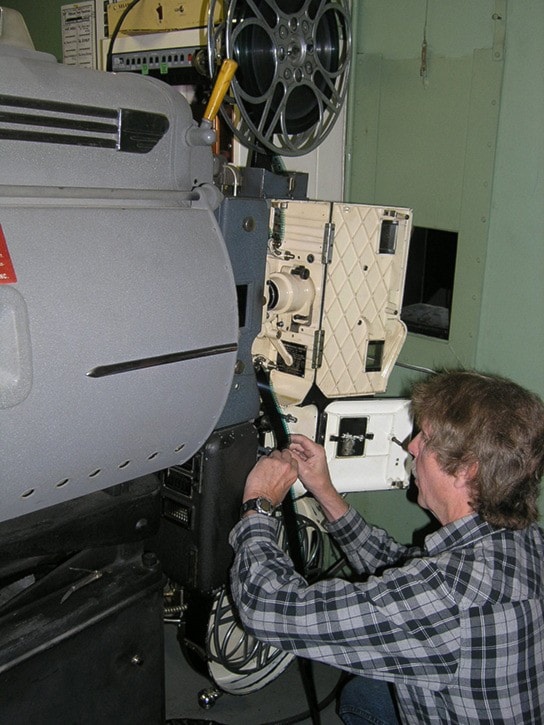By VERONIKA KURZ
Credit for bringing the silver screen to Terrace goes to George Minchin who, in the late 1910s, put on Saturday evening movies in the Progress Club, a community-owned hall on Lakelse Ave., across from where Urban Colour is today.
Not much has been recorded or remembered about Minchin.
The theatre operator that old-timers fondly reminisce about was a “florid-faced,” enterprising man named Fred Bishop who ran a theatre in the Oddfellows Hall, located in the same building as the Progress Club, from 1923 to 1933.
Bishop also maintained the first power-generating plant in Terrace, which powered the theatre, a small, ad hoc system of an old Ferguson tractor and a belt-driven generator.
“Sometimes the power plant would die in the middle of the movie,” Charles Houlden recalled, “and we’d have to wait till Fred got it working again.”
Throughout the ‘20s, audiences enjoyed black and white silent films, often accompanied by a live musician or band. Bishop’s daughter Mabel played a gramophone at the front of the theatre.
It only cost 25 cents to see a film and afterward young people would head over to Flossie Lambly’s Corner Snack Bar for a milkshake or piece of ‘Ma’ Lambly’s famous Boston cream pie.
Located on the southwest corner of Lakelse Ave. and Atwood St., the Corner Snack Bar had the first soft ice cream machine in town. It was open until midnight every evening, so movie-goers had somewhere to talk about the latest film stars.
In June of 1931, Bishop’s power plant caught fire, threatening to curtail Terrace’s enjoyment of the silver screen. Within half an hour of the outbreak of the fire, according to the local media, Bishop had found spare equipment, ensuring his patrons were not disappointed.
By the fall of 1931, Bishop had built a new and improved theatre next door to his downtown residence. “While silent pictures are being used at present,” the Omineca Herald reported, “arrangements have been made for the accommodation of talkies and it is hoped these pictures will be shown before long.”
Bishop’s new theatre had the capacity to seat 100. It had a sloping concrete floor facing the screen and was furnished with an electrical gramophone, an improvement over the hand-cranked gramophone (especially for Mabel).
Its construction, after the Depression had begun, was recognized in the Omineca Herald’s message congratulating Bishop for his “enterprise in going ahead with the project at a time when so many are looking on the dark side of things.”
It is unclear what happened to Bishop’s theatre: some old-timers recall Bishop not doing well financially, despite being popular with the locals. The Great Depression of the 1930s and the accompanying economic slump in the region were certainly factors. In 1933, Bishop left Terrace to join his brother in the theatre business in Victoria.
Ten years later, in 1943, Charlie Adam, a businessman formerly of Stewart, constructed a theatre on the 4600 block of Lakelse Ave. Not coincidentally, 1943 was also the year that saw 6,000 soldiers and highway workers flood into Terrace for ‘Home Defence.’ According to his stepsons Rob and Ed Hiensch, Adam “saw a need for entertainment for the troops.” This theatre was poorly insulated with hot water radiators—in winter, moviegoers would crowd around a large barrel stove—and had hard, uncomfortable benches.
Adam eventually purchased surplus army projecting equipment, allowing him to show 35 mm film—rather than the older 16 mm film. The picture produced on 35 mm is sharper and less grainy, but slightly more flammable.
Due to the higher risk, the fire chief required Adam to fireproof his projection room. Adam spent weeks scavenging tin cans and oil drums, which he cut into flat strips and nailed to the walls of the projection room, thereby reaching a measure of fireproofing.
Adam built the then-Tillicum Theatre in its present location on Lakelse Ave. in 1954. The new, Quonset-shaped theatre was warmly welcomed: it featured proper heaters, more comfortable seats, a large concession, and even a double-glazed ‘cry room’ for babies.
Movies were shown every evening, with a matinee on Saturdays. Marianne Brandis recalled working for Adam at the theatre: she sold tickets, orange juice, chewing gum, and popcorn (for 10 cents!),
Newsreels and promotions for upcoming films began at 8 p.m. The newsreels, Brandis recalled, were “always months out of date, one election or revolution merging into another.”
In 1958, Adam opened Tillicum Drive-in on the southwest corner of Keith Ave. and Braun St. The 40X80 foot screen showed movies on Fridays and Saturday nights throughout the summer and early fall, and operated into the late 1970s. During intermission between the two feature films, Rob and Ed Hiensch remember the concession becoming “a circus.” There was enough business to employ seven people behind the counter.
The Tillicum Theatre and the Tillicum Drive-in were both taken over in 1967 by Bill Young, who still owns the Lakelse Ave. theatre today. As part of his previous catering business, Young often showed movies during catering jobs in logging camps. When in Terrace to bid on a Nass Camp catering job, Young bumped into a friend, who introduced him to Adam, who was looking to sell the theatre.
Young added a second theatre in 1974, changing the name to Tillicum Twin Theatres. It is now capable of 3-D projection and continues to screen blockbuster Hollywood films, continuing a long Terrace tradition.
Veronika Kurz loves film, and spent the summer learning about local history as Heritage Park Museum’s community programmer. She is now back at the motion picture arts program at Capilano University. Kurz intends to become a filmmaker, and has recently launched her own film company, Dead Tree Film.
